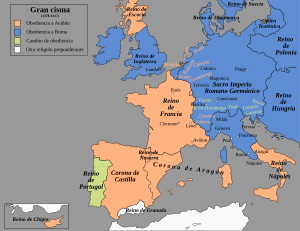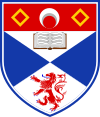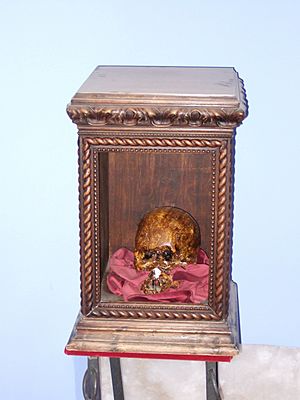Antipope Benedict XIII facts for kids
Quick facts for kids Antipope Benedict XIII |
|
|---|---|
| Pope Luna | |
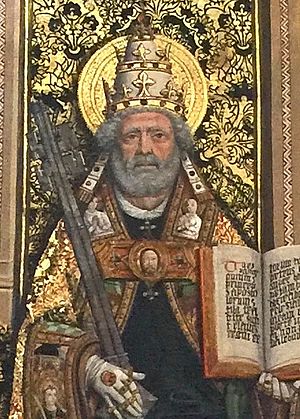
Portrait by Juan Rexach
(15th-century, Morella, Spain) |
|
| Elected | 28 September 1394 |
| Papacy began | 11 October 1394 |
| Quashed | 12 March 1403 |
| Papacy ended | 23 May 1423 |
| Predecessor |
|
| Successor |
|
| Opposed to | Roman claimants:
|
| Other posts | Cardinal-Deacon of Santa Maria in Cosmedin |
| Orders | |
| Ordination | 3 October 1394 |
| Consecration | 11 October 1394 by Jean de Neufchatel |
| Created Cardinal | 20 December 1375 |
| Rank | Cardinal-Deacon |
| Personal details | |
| Birth name | Pedro Martínez de Luna y Pérez de Gotor |
| Born | 25 November 1328 Illueca, Crown of Aragon |
| Died | 23 May 1423 (aged 94) Peniscola, Crown of Aragon |
| Buried | Castillo Palacio del Papa Luna, Illueca (skull) |
| Occupation | Professor |
| Previous post | Apostolic Administrator of Avignon (1394–1398) |
| Alma mater | University of Montpellier |
| Coat of arms |  |
| Other Popes and Antipopes named Benedict | |
Pedro Martínez de Luna y Pérez de Gotor (born November 25, 1328 – died May 23, 1423) was a Spanish nobleman. He is known as Pope Luna in English and el Papa Luna in Spanish. He was considered an antipope by the Catholic Church during a time called the Western Schism.
Contents
Early Life of Pedro de Luna
Pedro Martínez de Luna was born in 1328 in Illueca, which was part of the Kingdom of Aragon (now Spain). His family, the de Luna family, was an important noble family in Aragon. He studied law at the University of Montpellier and earned a doctorate. Later, he taught canon law, which is the set of rules and laws of the Catholic Church.
His strong knowledge of church law, his noble background, and his simple lifestyle impressed Pope Gregory XI. Because of this, Pope Gregory XI made him a Cardinal Deacon in 1375.
The Avignon Election and the Schism
In 1377, Pedro de Luna and other cardinals went back to Rome with Pope Gregory XI. The Pope had been convinced to leave his base in Avignon, France. After Pope Gregory died in 1378, the people of Rome worried that the cardinals would choose a French pope. They feared the papacy would move back to Avignon.
The people rioted and demanded an Italian pope. The cardinals then elected an Italian, Bartolomeo Prignano, as Pope Urban VI. However, the new pope was very difficult to work with. Some cardinals met again in September 1378. They said the first election was not valid and chose Robert of Geneva as their new pope. This started the Western Schism, a time when there were two (and later three) people claiming to be the true Pope. Robert took the name Antipope Clement VII and moved back to Avignon.
Clement VII sent Pedro de Luna to Spain to gain support for the Avignon pope. Because of his powerful family, he was very successful in Aragon. In 1393, Clement VII made him a special representative to France, Scotland, England, and Ireland.
After Clement VII died in 1394, the cardinals in Avignon met. They all wanted to reunite the church. They elected Luna as the new pope. They made him promise to work to end the schism and to resign if the Roman pope did the same, or if the cardinals asked him to.
The Roman cardinals had already chosen Pope Boniface IX in 1389. So, Benedict's election meant the Western Schism continued. At first, France, Scotland, Sicily, Castile, Aragon, and Navarre recognized him as pope.
Benedict XIII's Time as Pope

In 1398, France stopped recognizing the Avignon popes. Many of Benedict's cardinals also left him. Only five stayed loyal. Benedict believed he was the only true pope. He argued that he was the last living cardinal chosen by Gregory XI, who was the last undisputed pope. He felt this made him the only rightful candidate. However, this idea was not widely accepted later.
An army led by Geoffrey Boucicaut attacked Avignon. They began a five-year siege of the Papal Palace. Benedict managed to escape in 1403. He found safety in the territory of Louis II of Anjou. Avignon soon recognized him again, and his cardinals returned. Public opinion shifted in his favor, and France, Scotland, Castile, and Sicily again recognized him as the true pope.
After the Roman Pope Innocent VII died in 1406, the new Roman pope, Pope Gregory XII, started talks with Benedict. He suggested they both resign so a new pope could be elected to unite the Catholic Church. When these talks failed in 1408, Charles VI of France declared that his kingdom would not support either pope.
Charles helped organize the Council of Pisa in 1409. This council was meant to make both Gregory and Benedict resign so a new, universally recognized pope could be chosen. Benedict held his own meeting, the Council of Perpignan, but it did not have much success. Since neither Benedict nor Gregory would step down, the Council of Pisa only resulted in a third person claiming to be pope: Peter Philarghi, who became Antipope Alexander V.
University of St Andrews
In 1410, a group of Augustinian clergy started a school in St Andrews, Fife, Scotland. They had been forced to leave other universities because of the Schism and wars. The Bishop of St Andrews, Henry Wardlaw, asked Benedict to make the school a university. Benedict did so by issuing official church documents (papal bulls) on August 28, 1413.
By this time, Benedict had lost France's support and had left Avignon. He had found refuge in Perpignan, near the border of Aragon. But Scotland remained loyal to him. Today, the University of St Andrews's coat of arms still includes a symbol from Benedict's family.
Etsi doctoribus gentium
To try and gain more support, Benedict started a year-long debate called the Disputation of Tortosa in 1413. This was a very important discussion between Christians and Jews during the Middle Ages. Two years later, Benedict issued a special church order called Etsi doctoribus gentium. This order included many rules that were difficult for Jewish people. However, these rules were later canceled by Pope Martin V in 1418.
The Council of Constance
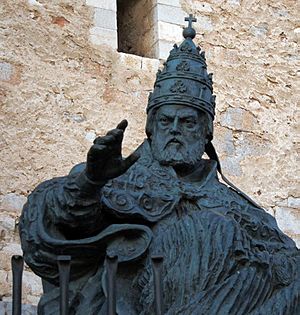
In 1415, the Council of Constance aimed to end the conflict between the different papal claimants. Gregory XII and Baldassare Cossa (who had become the Pisan pope, Antipope John XXIII) both agreed to resign. However, Benedict refused to step down.
Sigismund, Holy Roman Emperor organized a meeting in Perpignan to convince Benedict to resign and end the Western Schism. Many important leaders attended, including the Emperor, the King of Aragon, and representatives from other kingdoms. But Benedict still refused to resign.
Because of his refusal, the Council of Constance declared Benedict a schismatic (someone who causes a split in the church). They excommunicated him from the Catholic Church on July 27, 1417. On November 11, 1417, they elected Martin V as the new, widely accepted pope.
Benedict had lived in Perpignan from 1408 to 1417. After being excommunicated, he fled to the Peniscola Castle, near Tortosa, in the Kingdom of Aragon. He still believed he was the true Pope. Only the King of Aragon, Alfonso V of Aragon, continued to protect him. Benedict stayed at Peñíscola until he died there on May 23, 1423.
Succession After Benedict XIII
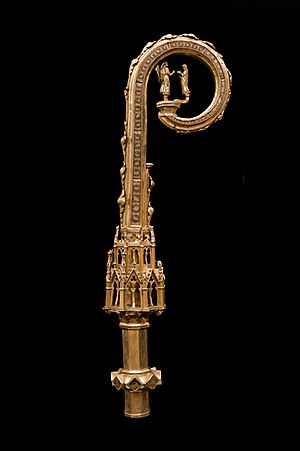
The day before he died, Benedict chose four cardinals he trusted. He wanted them to elect a new pope who would continue the Avignon line. Three of these cardinals met on June 10, 1423. They elected Sanchez Muñoz as their new pope, who took the name Antipope Clement VIII. Aragon still recognized him. The fourth cardinal, Jean Carrier, was not there and did not agree with the election. He then chose Bernard Garnier as pope, who took the name Antipope Benedict XIV, but he was not important.
In 1429, an agreement was made between Rome and Aragon. Clement VIII then gave up his claim to be pope and recognized Pope Martin V. This finally ended the Avignon line of anti-popes. In return, Clement VIII was made a bishop.
Burials
Benedict XIII was first buried in Peñíscola castle. His body was later moved to Illueca. However, during the War of the Spanish Succession, his remains were destroyed. Only his skull was saved. It was kept in the palace of the Counts of Argillo in Sabiñán, Aragon, Spain.
In April 2000, the skull was stolen from the ruined palace. The thieves sent a letter asking for money. The Spanish Civil Guard found the thieves, who were two brothers. They were sentenced in November 2006. The skull was found in September 2000. After being studied, it was placed in the Zaragoza Museum, but it is not currently on display.
Attempted Rehabilitation
On December 21, 2018, a group called "Friends of Pope Luna" asked the Congregation for the Doctrine of the Faith to recognize Benedict as a true pope.
See Also
 In Spanish: Benedicto XIII (antipapa) para niños
In Spanish: Benedicto XIII (antipapa) para niños
- Papal selection before 1059
- Papal conclave (since 1274)


